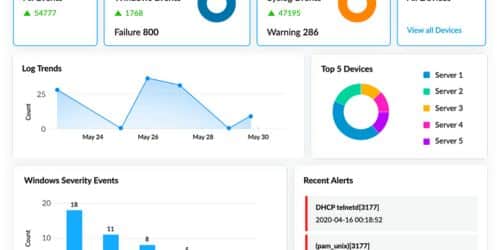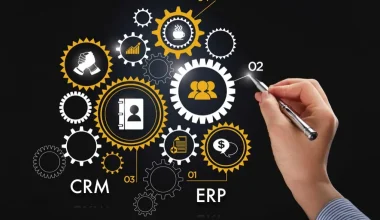Log management tools boost security, aid in troubleshooting, and allow for system monitoring. This log management guide covers essential terminologies and discusses the advantages of using centralized tools.
What is a Log?
A log file is a collection of data that is generated automatically when certain events occur in systems, networks, and applications. They create records that document activities for:
- Users
- Servers
- Networks
- Computer operating systems
- Applications/Software
- Event logs, for example, may keep track of:
- When a computer’s backup was completed
- Errors that prevent an application from starting
- Files downloaded from a website by users
They are used by security and IT operations teams to examine and respond to unusual system activity.
Logs can be in one of two formats. A human can open and read some of them. Others are solely machine-readable and are preserved for auditing purposes.
Here are some examples of log types:
- Audit Logs
- Transaction Log
- Events Log
- Error Log
- Log files for messages
- Security Logs
Finally, logs are available in a wide range of formats and extensions, including as
- .log
- .txt
- JSON
- .csv
- .dat
You can open log files with the following programs, depending on the extension and readability:
- Notepad is a standard text editor.
- Word processing software such as OpenOffice or Microsoft Word
- PowerShell is a command-line application.
- Microsoft Excel
- OpenOffice Calculator
- Calc in LibreOffice
What is Log Management?
Log management is the process of managing event logs, which includes the following log activities:
- Generating
- Transmitting
- Storing
- Analyzing
- Disposing
Compliance relies heavily on log management. Because event logs contain all data concerning activities in the environment, they serve as documentation for audits. For example, log management can assist in meeting various compliance requirements, such as those for:
- The Federal Information Security Management Act of 2002 (FISMA) was enacted in 2002.
- The Health Insurance Portability and Accountability Act (HIPAA) of 1996
- SOX (Sarbanes-Oxley Act of 2002)
- GLBA (Gramm-Leach-Bliley Act)
- PCI DSS (Payment Card Industry Data Security Standard)
- GDPR (General Data Protection Regulation)
What is Centralized Log Management?
A centralized log management solution is a technology that allows businesses to handle all types of logs. These include those from their on-premises, cloud, and hybrid settings, which are enabled by activating the following:
- Ingestion of records from various systems, networks, applications, and devices
- Aggregation: The process of merging an increasing number, volume, and variety of log sources in a single area.
- Parsing: extracting the relevant information from each event log for usability.
- Normalization entails developing a consistent format for all event log data.
- Correlation is the process of connecting information about events from many settings in order to gain a better understanding of what is going on.
- Analysis: creating high-fidelity warnings by automating connected data points.
A centralized logging platform provides high-fidelity warnings to operations and security, allowing them to notice, investigate, and respond to issues more quickly.
SIEM vs. Log Management
The log file or event log is used by both SIEM and log management software to improve security by lowering the attack surface, identifying threats, and improving response time in the case of a security incident.
The essential distinction is that the SIEM system is designed with security as its primary role, whereas log management solutions can be used to manage resources, solve network or application problems, and maintain compliance.
How Do Log Management Tools Work?
Everyone has visibility into what’s going on across the various IT environment with a centralized log management solution. More significantly, centralized log management makes it simpler to respond to issues such as down servers or security breaches. However, understanding how centralized log management solutions function is also vital for better understanding their worth.
#1. Log Collection
The first step in log management is deciding how to gather and store log data. This is the primary benefit of a centralized log management solution.
The following components of the IT environment generate log data:
- Computer systems,
- Firewalls,
- Servers,
- Switches,
- Routers,
- Workstations
- Applications
- IDS (intrusion detection systems)
- Intrusion detection and prevention systems (IPS)
- Anti-virus Solution
- EDR (endpoint detection and response) solutions
Several EPS (events per second) can be generated by each system, software, and device. This is why utilizing a log collector capable of handling the corresponding number of logs is important.
You can define and personalize the log data you want with a centralized log management solution.
Log Collection Strategies
You should arrange to log data collection settings to exclude redundant data while collecting all necessary information. This is a simple strategy that boosts performance and efficiency.
Another technique to log collection is to use a maximalist strategy. This entails gathering all relevant data so that the log management application may organize and analyze it. While there are other disadvantages to this strategy, the two most significant ones are:
- Cost increases: Storing a big volume of data is costly and necessitates additional staffing to oversee the process.
- Reduced efficiency: Keeping extremely huge data sets online reduces overall performance.
Long-Term Log Retaining and Storage
The collection allows you to store and retain logs for an extended period of time. Many compliance laws involve log storage and retention, so you should factor this into your log collecting. In general, best practices recommend preserving log data for at least one year in case further research is required.
When saving logs, you have the option of backing up data to on-premises servers or the cloud. This decision is frequently made in conjunction with a company’s decision to go digital and transfer its resources online.
Log Rotation
Log rotation automates the process of renaming, resizing, transferring, or deleting large or obsolete log files.
You can specify a time interval after which the log will be generated:
- Deleted.
- Compressed to save space.
- Emailed to another location.
This creates new storage space for more current log files.
#2. Log Aggregation
Without a centralized log management solution, aggregating all log data in one place might be difficult. Among the difficulties are:
- Massive amounts of data
- Log data precision
- Formats vary between systems, networks, applications, and devices.
Even though your log management system can handle massive amounts of data, how quickly this data is generated is critical. This rate should be supported by log management tools. This is why the EPS of a tool should be considered while selecting one.
#3. Log Parsing
You want to concentrate on the information that is most important to meet your needs. Log parsing is the process of extracting the most important data from a log.
Every event log entry is labeled with a kind. You’ll typically find the following event log types:
- Information: a basic explanation of something that should have happened.
- Warning: Notification of an incident that may not be relevant right now but indicates a problem that may arise later.
- Error: Something went wrong, causing a major problem.
- Success audit: A security log confirming that an audited security event was successfully completed.
- Failure audit: A security log entry indicating that an audited security event did not successfully completed.
Furthermore, each audit log may include the following information:
- Date
- Time
- User
- Computer/Device
- Event Identifier
- Source
- The type of incident
- Event description
#4. Log Normalization
Parsing data allows you to obtain the information you require. Log normalization allows you to generate a consistent format for all event logs.
For example, some of the numerous sorts of log formats that you may be collecting are as follows:
- Syslog: messages from network devices such as routers and switches.
- JavaScript Object Notation (JSON): a format that both people and machines can understand.
- Records from Windows-based operating systems and apps are stored in the Windows Event Log.
- Common Event Format (CEF): a text-based, flexible, and easily accessible format.
Event Correlation
There are many interrelated systems, networks, and applications in a modern, complex IT environment. You must comprehend all of the dependencies and be able to trace the problem back to its source.
The technique of merging several occurrences to see the correlations that exist is known as correlating events. A server outage, for example, may have an influence on application performance. Your IT team, on the other hand, received a help desk call concerning the delayed application.
You can speed up the root cause analysis by linking the events.
Log Analysis
By parsing, standardizing, and correlating the data you collect, log analysis makes use of it.
Centralized log management tools automate and simplify the log data analysis process. Charts and graphs highlight the relationships and similarities between events and data. This makes detecting problems and determining their causes easier.
The following are the most common applications for log analysis:
- compliance
- security
- troubleshooting
- enhancement of performance
What are the Main Benefits of Log Management and Monitoring?
Log management is critical because it enables you to take a methodical approach to gain real-time insights into operations and security.
Among the advantages of log management and monitoring are:
- System control
- High-quality warnings
- Improved security
- Enhanced troubleshooting
- improved resource utilization
- Better compliance posture
#1. System Control
One of the advantages of log management is that it allows you to monitor everything that happens in your diversified IT environment. Furthermore, as part of system monitoring, various personnel receive the same visibility for improved communication. Centralized system monitoring, for example, allows for:
- IT Administration
- DevOps
- Developers
- Computer Systems Administrators
- Operational security
This visibility can provide insight into performance concerns that may foreshadow potential or future problems.
You can communicate information with Graylog via emails, collaborative tools, and ticketing systems.
#2. High Fidelity Alerts
The capacity of centralized log management to correlate and analyze event log data also implies that you can generate high-fidelity alerts. You can configure monitoring settings to track a specific collection of events and receive configurable real-time notifications. These warnings enable you to respond more quickly and reduce downtime.
#3. Improved Security
High-fidelity notifications also improve security. You may have a dedicated security team or employees managing security functions within the IT team. Everyone is overwhelmed in both circumstances by the high number of warnings, many of which are false positives.
By connecting events, you may limit the number of false positives and prioritize security response efforts. This enhances detection, shortens response times, and lowers risk. The shorter the time threat actors spend in your environment, the less damage they may cause.
You may also employ log management to transform your SIEM into a proactive security tool for threat hunting.
#4. Quicker Troubleshooting
Log management gives you greater control and insight into your environment’s processes. Data mining capabilities are built into log management solutions. They can sift through massive amounts of log data to uncover patterns that would otherwise go unnoticed.
Log analytics allows you to tailor search and analysis to benefit from the enormous quantity of data collected in logs. You can use both organized and unstructured logs with advanced search capabilities. This allows you to collect information about specific incidents that will aid in determining the root cause.
It is now easier to:
- Recreate the sequence of events that caused the problem.
- Make links with other events.
- Determine the source of the problem.
#5. Adequate Use of Resources
Performance monitoring can assist you in tracking resource utilization. Frequently, someone will submit a help desk ticket claiming that an application is not responding. This could, however, be the result of a server overload.
Centralized log management allows you to see performance concerns and bottlenecks. You relieve the stress on your IT personnel by optimizing resource consumption.
Centralized log management can provide visibility into consumption in cloud environments around:
- Workloads
- Applications
- Various environments
- Assets that have been forgotten
Having visibility into this can assist you in optimizing your cloud expenses.
#6. Compliance Posture Improvement
Log reporting uses numerical and visual features to summarize the search and analysis processes.
Log reports can be used to show your findings to non-technical people. This data can be shared with senior management or the Board of Directors. They have the data to verify governance over the security program by evaluating these reports, which is critical for compliance.
Common Log Management Challenges
The growth of linked devices, as well as the migration to the cloud, have increased the complexity of log management for many enterprises. A modern, successful log management solution must address the following key issues:
#1. Standardization
Because log management collects information from numerous applications, systems, tools, and hosts, all data must be consolidated into a single system that adheres to the same standard. This log file will assist IT and information security professionals in effectively analyzing log data and producing insights used to carry out mission-critical services.
#2. Volume
Data is being generated at an unbelievable rate. The volume of data regularly generated by applications and systems necessitates a huge amount of effort for many organizations to efficiently acquire, prepare, analyze, and store. A log management system must be designed to handle massive amounts of data while also providing timely insights.
#3. Latency
Indexing within log files can be a computationally expensive process, resulting in a lag between data entering a system and being included in search results and visualizations. Depending on how and if the log management system indexes data, latency can rise.
#4. Significant IT Burden
Log management is extremely time-consuming and costly when done manually. Some of these operations can be automated using digital log management tools, reducing the burden on IT personnel.
The most difficult aspect of logs is the massive amount of data. In many circumstances, IT professionals aren’t actively examining and mining log data. It’s understandable: no one wants to manually review a large number of logs every day.
However, because event data might be the first indication that a critical application or service is running out of resources or seeing a spike in demand, organizations must invest in effective log management tools and best practices to ensure they are getting the most out of their data.
Best Log Management Practices
#1. Purchase Tools
Many of the time-consuming processes associated with event log management can be automated using log management software. Some firms may make the mistake of attempting to construct their own log monitoring infrastructures, however, this is not advised if time and money are constraints. There are numerous low-cost vendor log management tools available that provide value straight away.
#2. Centralized Logging
The act of consolidating all log data into a single, accessible area is known as centralized log management. Having all logs in one area simplifies log management. Centralized logging tools can assist you in organizing data from several sources, searching for specific logs, and enforcing retention standards to ensure logs are available at specific times. Furthermore, centralized logging facilitates the sharing of log data with other business contacts.
#3. Understand What to Keep an Eye On
It’s critical to plan ahead of time so you know what you need to monitor and what you don’t. Businesses frequently make the mistake of assuming that something should be logged simply because it can. This will have a negative impact on your log management approach because logging too many data points can make finding the most critical data more difficult. It also increases the complexity (and cost) of your log storage.
However, it is necessary to log any form of production environment data that is critical for daily processes or application development. Similarly, you should log any data that is useful for analyzing performance issues or resolving user experience concerns. The data from these logs can have a direct impact on your day-to-day operations.
#4. Create Log Security
Because log data frequently contain sensitive information, enterprises must choose a provider that gives IT professionals complete control over their data. The first step for tech teams looking to secure their data is to choose a secure data transmission solution.
Enhanced transfer protocols enable IT professionals to encrypt all sensitive log data before sending it to a trusted partner. Secure accounts and role-based access management are also crucial security elements. Users can be provided login credentials, and IT professionals can specify specific permissions to keep their data safe and monitored.
#5. Scale Services
Log data takes up space, which is compounded when severe system problems occur and accelerate log file growth due to increased mistake rates. This unpredictability is costly and time-consuming for tech teams to manage manually. Businesses should invest in a hosted cloud solution that can automatically scale to save time and money as log generation fluctuates.
Tools for Log Management, Monitoring, and Analytics
#1. Retrace
Are you sick of chasing bugs in the dark? You don’t have to, thanks to Retrace. With this package of critical tools, including logging, error monitoring, and code-level performance, you can retrace your code, detect errors, and enhance application performance.
Key characteristics include:
- Log, error, and APM data are combined.
- Logging that is both structured and semantic
- Capabilities for advanced searching and filtering
- Custom log properties can be viewed and searched for.
- Automatic color coding to highlight faults and warnings
- Tracking and reporting on the origins of log messages in your code
- Traces of web queries and transactions
- View the whole application error details
- Investigate all of your logging fields.
- Analyzing logs
- Log tracking in real time
- Make use of tags (highlighted in your logs).
- Supports numerous application and server logs
Cost:
- QA/Pre-Production Servers start at $10 per month.
- Production Servers are priced between $25 and $50 per month.
#2. Logentries
Logentries is a cloud-based log management platform that makes any sort of computer-generated log data available to any size group of developers, IT engineers, and business analysts. The simple onboarding process of Logentries ensures that any business team can rapidly and efficiently begin interpreting their log data from day one.
Key characteristics include:
- Contextual view, custom tags, and live-tail search are all available in real time.
- Dynamic scaling for various infrastructure types and sizes.
- Extensive visual analysis of data trends.
- Custom alarms and pre-defined query reporting.
- Modern security measures to keep your data safe.
- Integrates seamlessly with top chat and performance management tools.
Cost:
- Free: $0
- Starter price: $39
- Pro: $99
- Team: $265
- Enterprise: Request a quote.
#3. GoAccess
GoAccess is a real-time log analyzer software designed to be run from a Unix system’s terminal or a browser. It provides a fast logging environment in which data can be presented milliseconds after it is saved on the server.
Key characteristics include:
- True real-time; updates log data within the terminal environment in milliseconds.
- Log strings can be customized.
- Page response time should be monitored; this is especially important for apps.
- Simple configuration; simply select your log file and launch GoAccess.
- Real-time analytics for your website visitors.
Cost: Nothing (Open-Source).
#4. Logz.io
Logz.io simplifies the process of locating crucial events and data created by logs from apps, servers, and network settings by utilizing machine learning and predictive analytics. It is a SaaS platform with a cloud-based backend powered by the ELK Stack (Elasticsearch, Logstash, and Kibana). This environment enables real-time visibility into any log data that you are attempting to examine or comprehend.
Key characteristics include:
- Use ELK as a Service to examine logs in the cloud.
- Before key log events reach production, cognitive analysis delivers them.
- Five minutes to production after a quick set-up.
- Businesses of all sizes can benefit from dynamic scaling.
- AWS-built data security to keep your data safe and intact.
Cost:
- Free: $0
- Pro: Prices start at $89
- Enterprise: Request a quote.
#5. Graylog
Graylog is a free and open-source log management software that allows for detailed log gathering and analysis. The log management software is used by teams in Network Security, IT Operations, and DevOps to identify potential security issues, follow compliance standards, and understand the underlying cause of any error or problem that your apps are facing.
Key characteristics include:
- Using a sophisticated processing algorithm, enrich and parse logs.
- Search through an infinite quantity of data to find what you’re looking for.
- Custom dashboards for displaying log data and searches visually.
- Custom alarms and triggers are used to track any data problems.
- Team members are managed by a centralized management system.
- Permission management for users and their roles can be customized.
Cost:
- Open-Source means “free.”
- Enterprise: Prices start at $6,000 per year.
#6. Splunk
Splunk’s log management product is aimed at enterprise customers who require simple tools for searching, diagnosing, and reporting on data log events. Based on a multi-line approach, Splunk’s software is designed to enable the process of indexing and interpreting logs of any sort, whether structured, unstructured, or sophisticated application logs.
Key characteristics include:
- Splunk understands all types of machine data, including servers, web servers, networks, exchanges, mainframes, and security devices.
- A versatile user interface for searching and evaluating data in real-time.
- Drilling algorithm for detecting abnormalities and recurring patterns in log files.
- Monitoring and alerting system for keeping track of significant events and actions.
- Visual reporting through the use of an automated dashboard output.
Cost:
- 500MB of data per day is provided for free.
- Splunk Cloud: Prices start at $186.
- Splunk Enterprise costs $2,000 to get started.
#7. Logmatic
Logmatic is a comprehensive log management solution that works with any language or stack. The solution works with both front-end and back-end log data and provides a simple online dashboard for accessing vital insights and information about what is going on in your server environment.
Key characteristics include:
- Upload and Go – send any type of log or metric, and Logmatic will organize them for you.
- Custom parsing rules allow you to sift through large amounts of complex data to uncover patterns.
- A powerful method for tracing logs back to their source.
- Dashboards that scale up time series, pie charts, calculated metrics, flow charts, and so forth.
Cost:
- $49 for the basic package
- Pro: $99
- $349 for the Enterprise
#8. Logstash
Elasticsearch’s Logstash is a well-known open-source log management application for managing, analyzing, and transferring log data and events. Logstash functions as a data processor, combining and transforming data from numerous sources at the same time before sending it to your preferred log management platform, such as Elasticsearch.
Key characteristics include:
- Without losing concurrency, ingest data from a variety of sources, including logs, metrics, web apps, data storage, and AWS.
- Data parsing in real-time.
- Make structure out of unstructured data.
- Data security using pipeline encryption.
Open-Source is free.
#9. Sumo Logic
Sumo Logic is a unified logs and metrics platform that uses machine learning to evaluate your data in real time. The platform can instantly show the underlying cause of any particular issue or incident, and it can be configured to constantly monitor what is occurring to your apps in real-time. Sumo Logic’s main strength is its ability to work with data quickly, eliminating the need for external data analysis and management tools.
Key characteristics include:
- All logs and metrics are collected on a single platform.
- Machine learning and prediction algorithms are used in advanced analytics.
- The setup is simple.
- High-resolution measurements are supported.
- Multi-tenancy means that a single instance can serve multiple groups of users.
Cost:
- 500MB per day for free
- $90 for a professional.
- $150 for the enterprise
#10. Papertrail
Papertrail is a slick hosted log management application that aggregates, searches, and analyzes any sort of log file, system log, or plain text log file. Its real-time features enable developers and engineers to observe live events for apps and servers as they occur. Papertrail integrates with services such as Slack, Librato, and Email to enable you to set up notifications for patterns and anomalies.
Key characteristics include:
- The UI is simple and easy to use.
- Simple setup; logs are directed to a link provided by the service.
- Real-time updates are made to log events and searches.
- Full-text search is available. Messages, metadata, and even substrings are all possible.
- Create a graph using Librato, Geckoboard, or your own service.
Cost:
- 100MB free per month
- Pro: Prices start at $7/month for 1GB of data.
Related Articles
- LOG MANAGEMENT TOOLS: Definition, Free, and Best Log Management Tools [2023]
- ELD DEVICES: Definition, Best Devices, Trucks & Owner Operators
- INCIDENT MANAGEMENT: Guide To The Process & Best Practices
- ACCOUNT MANAGEMENT: Definition, Skills, System, Salary & Duty
- INNOVATION MANAGEMENT: Key Elements and Strategies






